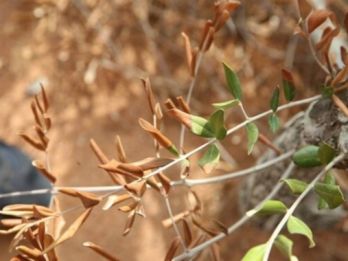Xylella fastidiosa
Xylella fastidiosa is a bacterial pathogen carried by insects, causing different diseases in many plants.
Background
Xylella fastidiosa infects more than 350 host plants from over 70 botanical families. It continues to spread around the world, affecting more species each year. Areas with mild winters are most impacted.
The bacterium has not been found in Australia but is a major concern for our plant industries and environment.
Subspecies of Xylella fastidiosa
Subspecies of Xylella fastidiosa
| Scientific name | Reported hosts | Associated diseases | Location |
|---|---|---|---|
X. fastidiosa subsp. fastidiosa:
| alfalfa, almond, walnut, peach, cherry, grape, elderberry, Rubus, citrus, avocado, coffee, guava, persimmon, maple, oleander, Eucalyptus, Nandina, mulberry | almond leaf scorch, Pierce’s disease of grapevines, alfalfa dwarf, bacterial leaf scorch, oleander leaf scorch, mulberry leaf scorch | North and Central America, Iran, China, Taiwan, Turkey, Italy, Israel |
X. fastidiosa subsp. multiplex | almond, pecan, walnut, blueberry, elm, oak, beech, ash, alder, liquidambar, sumac, oleander, ginkgo, peach, plum, cherry, grape, pear, olive, sycamore, mulberry, fig, sunflower, grasses, Acacia, Westringia | phony disease of peach, plum leaf scald, almond leaf scorch, pecan leaf scorch, blueberry leaf scorch, bacterial leaf scorch | North and South America, France, Spain |
X. fastidiosa subsp. pauca | citrus, coffee, olive, almond, peach, plum, walnut, oak, oleander, grasses, Acacia, Grevillea, Westringia | citrus variegated chlorosis, coffee leaf scorch, olive quick decline, almond leaf scorch, bacterial leaf scorch | Central and South America, Italy, Spain |
Xylella taiwanensis | Pear | Pear leaf scorch of Asian pear | Taiwan |
Impacts
Xylella fastidiosa is only found in the fluid vessels (xylem) of plants, which blocks the movement of water and nutrients. This can result in death of even mature trees in 1 to 2 years. Globally, the main hosts are:
- grapevine (Vitis vinifera, V. labrusca, V. riparia)
- citrus (Citrus spp., Fortunella)
- almond (Prunus dulcis)
- olive (Olea europaea)
- peach (P. persica)
- coffee (Coffea spp.)
- oleander (Nerium oleander).
The bacterium is transmitted by sharpshooters, leafhoppers, aphids, and spittlebugs. Any sap sucking insect in the suborder Auchenorrhynca can potentially transmit Xylella, including cicadas, aphids, planthoppers, and native Australian insects.
Insect vectors
Insect vectors
| Scientific name | Common name | Associated host disease |
|---|---|---|
| Acrogonia terminalis | citrus variegated chlorosis | |
| Cicadella viridis | green leafhopper | Pierce’s disease |
| Dilobopterus costalimai | citrus variegated chlorosis | |
| Draeculacephala minerva | green sharpshooter | Pierce's disease |
| Graphocephala atropunctata | blue-green sharpshooter | Pierce's disease |
| Homalodisca vitripennis | glassy-winged sharpshooter | Pierce's disease |
| Oncometopia fasciali | citrus variegated chlorosis | |
| Philaenus spumarius | spittlebug, meadow froghopper | olive quick decline syndrome |
| Xyphon fulgidum | redheaded sharpshooter | Pierce's disease |
Xylella fastidiosa also spreads by moving live planting material. It is not transmitted by seeds or mechanically, such as on pruning equipment.
Management
There are currently no cures available for diseased plants. Control options include:
- excluding vectors
- removing infected plants and alternative hosts
- planting less susceptible plant varieties
We recommended using pest-free propagation material and seedlings sourced from a reputable supplier.
Farm workers should follow on-farm hygiene practices and learn the signs to look for and report.
Identification
Xylella fastidiosa is easily confused with water stress and other plant diseases. It can cause:
- leaf browning, discolouration, or scorching
- loss of leaves
- stunted young shoots
- gradual reduction in fruit size
- dieback and eventual death of the plant.
It may not cause symptoms in all species and the signs can vary between hosts. Transmission from asymptomatic to symptomatic hosts is common.


